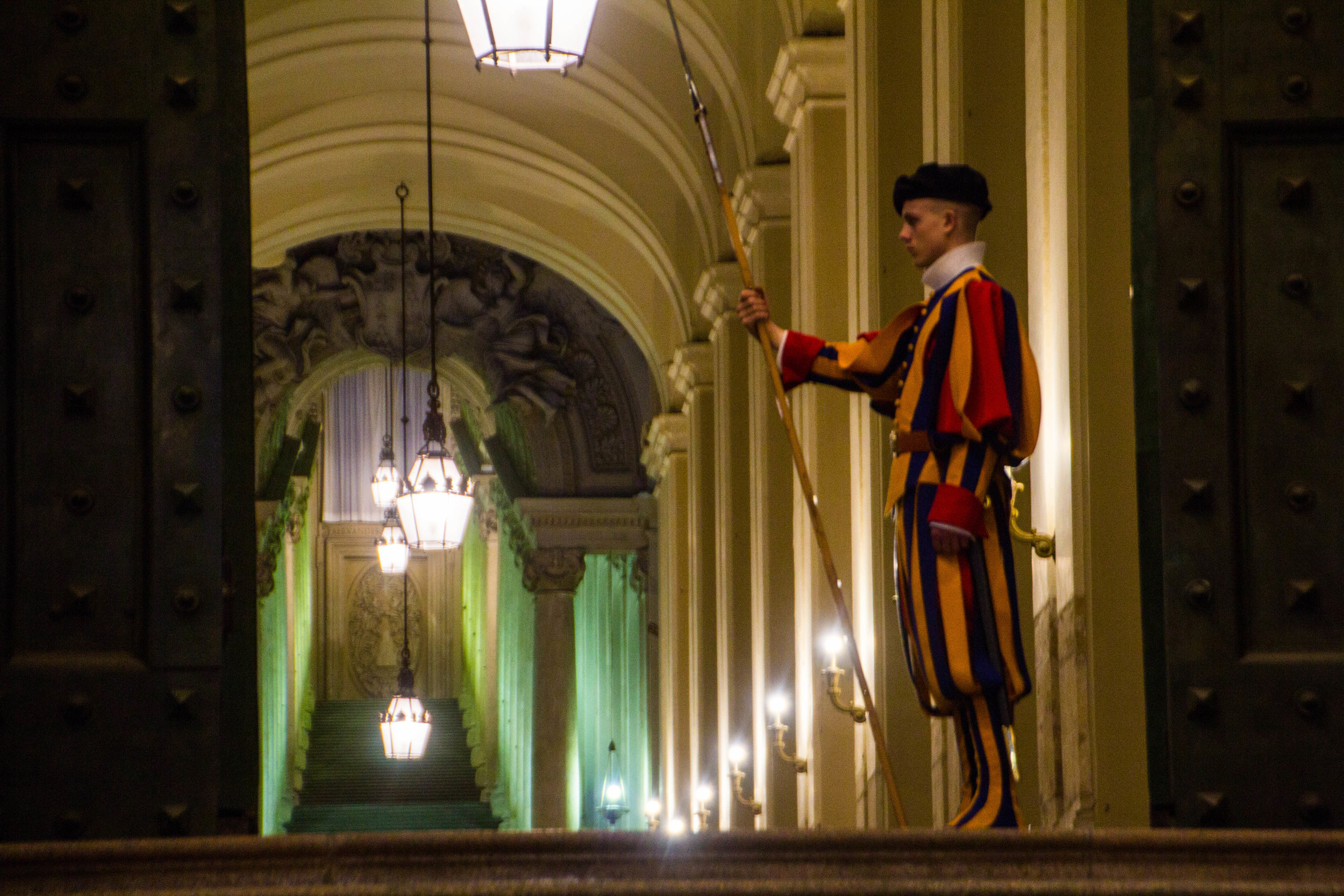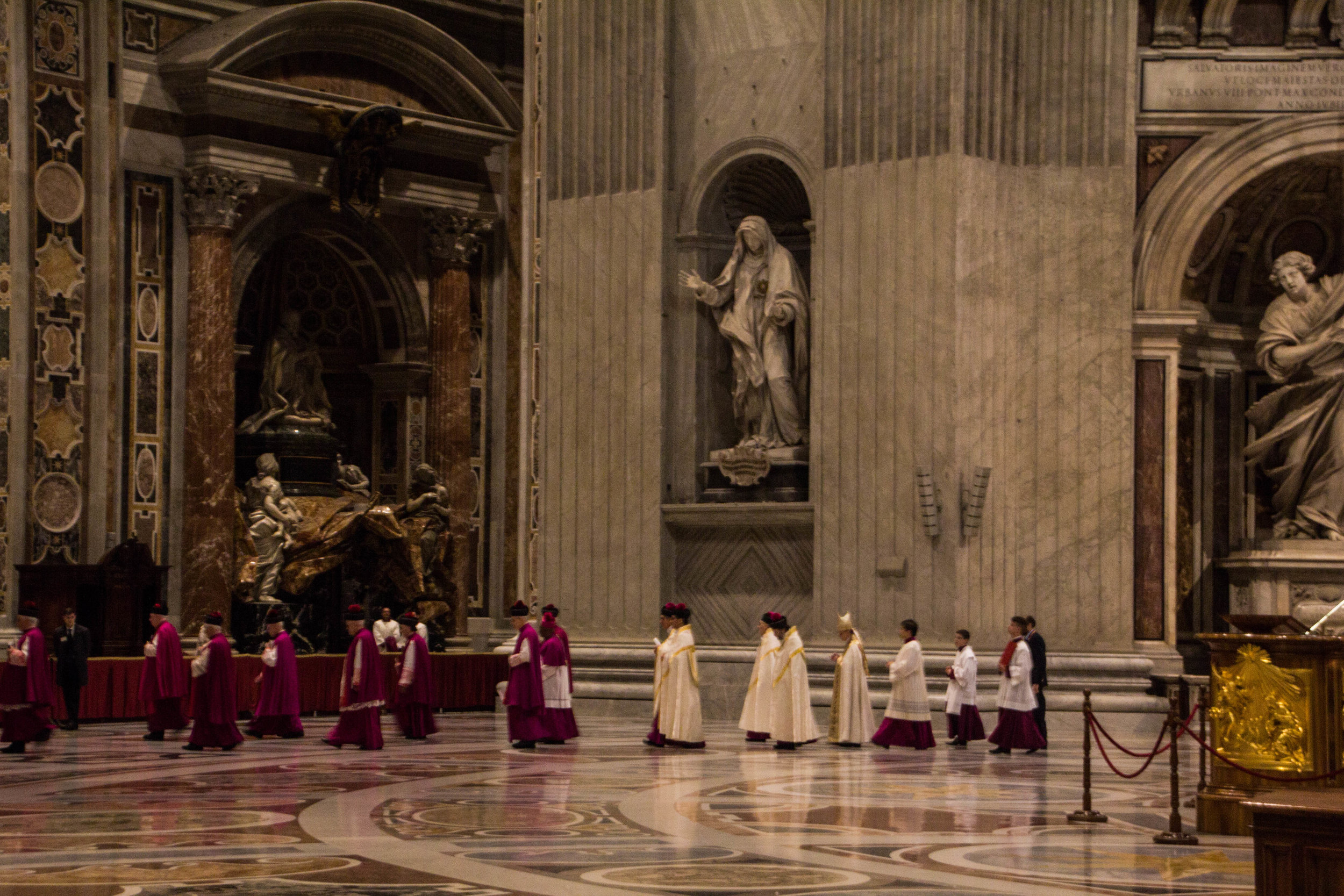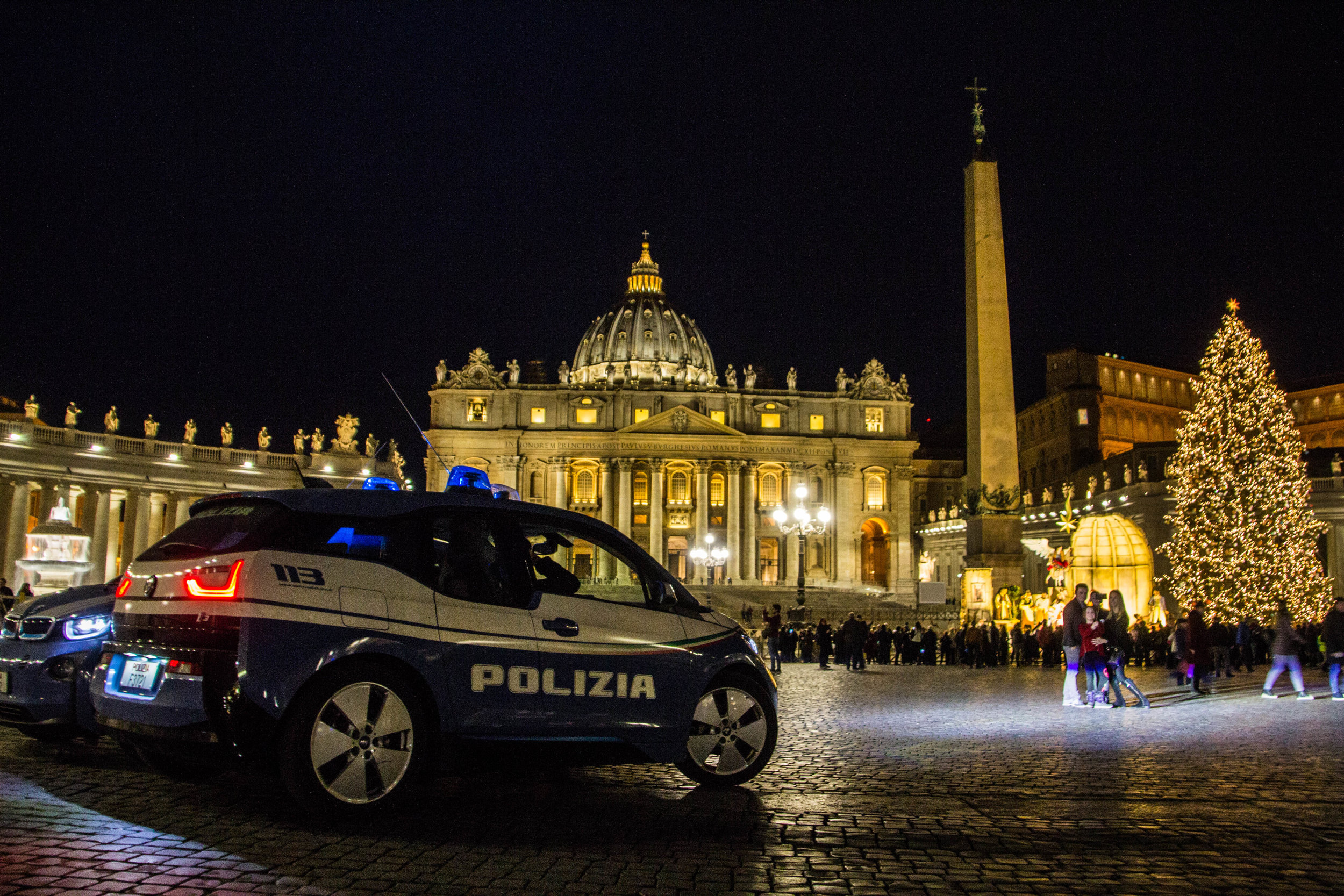We were in Rome by pure happenstance, on about as long a layover as it is possible to have in a single day. There was no hope of seeing ALL of Rome in a day, much less do it justice in an article, so we decided to break off a bite-sized piece and limit our explorations to a single neighborhood: Trastevere. However, as the sun began its slide down towards the horizon line, we decided to make one last stop before heading back to the airport: the Vatican.
Vatican City In 2 Minutes
The Vatican (or Vatican City) is a sovereign state (meaning, a whole different country) functioning within the confines of Rome. However, the sovereignty of this tiny country actually belongs to a separate organization called the "Holy See," which is essentially the Vatican's satellite government. With a population of about 1,000 and an area of 110 acres, the Vatican is the smallest country in the world in both categories. You will undoubtedly know the Vatican as the home of the Pope and the Cardinals, as well as the "mothership" for Catholicism. Its sovereignty did not become official until 1929, but its history as a holy site stretches back much MUCH farther... all the way back to the death of St. Peter.
St. Peter was executed in Rome by the infamous Roman Emperor Nero in the year 64 A.D. According to tradition, he was crucified upside down and buried on the Western side of the Tiber river, which was mostly marshes at the time. It was not until the year 313 A.D. that Emperor Constantine accepted Christianity. 10 years later, Christianity was the official religion of the Roman Empire, so soon afterwards, construction had begun on a church, situated on top of St. Peter's Tomb. This would ultimately become Papal Basilica of St. Peter, which is the centerpiece of Vatican City today.
That's pretty cool. The Vatican is built on top of St. Peter's grave. That's THE Peter, from the bible.
Needless to say, the Vatican is a historical hotspot and has long been at the center of Western politics. Millions of catholics make the pilgrimage to the Vatican every year, along with millions more non-catholics (like myself). Talking about this place, you could go on forever, but I'll let our history lesson end here, and leave you with this interactive map. Zoom in and poke around!
The road to The Vatican is a crowded cobblestone causeway which is called Via della Conciliazione. It's as wide as an 6 lane highway, and it stretches from the western bank of the Tiber river to Piazza San Pietro (St. Peter Plaza). From dawn until well past dusk, this massive street is awash with tourists from all over the world. It's a riverbed for foot traffic, and down many of its alleyways and offshoots, you can see Italian police officers and military personnel standing guard.
We arrived at the foot of this street in later afternoon. The sky was gray, and the air held a cold moisture. We followed the masses of people up the road towards the giant stone gates. On either side of these gates, giant Roman columns stretched off endlessly. These marked the border between Italy and Vatican City. Perched on either side of the entrance were Italian military outposts manned by heavily armed but very bored-looking soldiers. This wasn't exactly the front lines.
Crossing into Piazza San Pietro, though an international boundary, was decidedly anti-climactic. But it was a HUGE area. Huge enough that, from the middle of the plaza, everything—even the giant Roman columns surrounding us—looked small off in the distance. However, the one thing that did NOT look small from this vantage point was the Christmas tree propped up in the middle of the plaza. It was early January at this point, but there was giant nativity scene set up nevertheless.
Below are a few pictures of Piazza San Pietro. Take note of the how small people look standing next to the columns. The topography of this plaza is so spread-out that it's easy to lose perspective of how big everything here is from a distance.
The people surrounding us in this giant plaza were an interesting amalgamation. I was struck by the diversity of people that I saw here. Of course there were many different ethnicities and cultures present, but the age range of the people in this crowd was particularly unusual. What I'm trying to say is, there were a LOT of old people. There were also small children running through the crowd yelling to one another, but there elderly were the defining demographic. I particularly love the photo below of the woman in the wheelchair getting her picture taken. I like to think that I captured the fulfillment of a lifelong dream there.
There were also large groups of nuns walking around, no doubt making the pilgrimage from far flung convents and churches around the world. From what I could overhear from these groups, most of them were not speaking Italian. It made me happy to see them here. I could tell they were having a great time. This is like nun Disneyland.
On one side of the nativity scene, a large group of women had formed a massive circle, and were singing Christmas carols together, although I'm not certain in what language. I worked my way through the crowd and took out my phone to take the following recording.
I thought it was a cool soundscape. The collective desperation of these masses of people for a genuine interaction with God was palpable. And I use the word "desperation" in the best possible way. I think that this is an important part of the human condition. We're complex beings, so the waters are often muddied when it comes to isolating what is happening inside of us. But here in the shadow of the Vatican, this need for spiritual meaning was on display for all to see. It was interesting people watching.
The line to get inside the Vatican was long. Like, really long. The sun was sliding lower in the sky, and our time here was running out, but we decided to get in line and try our luck. To our surprise, the line actually moved relatively quickly. We were going through secuirty in about 30 minutes.
Getting Past Vatican Security
At the end of the line to get into the main basilica, you enter a series of wooden banisters, reminiscent of the long networks of railing that corral lines of people onto roller coasters. You're already technically in a different country when you walk into Piazza San Pietro, but you won't go through any sort of customs or security until you get to the end of this line. I was hoping for a passport stamp, but no such luck. The security waiting for us at the end of this line was a less intense version of airport security.
Below are a few pictures of the final stretches of this line and Vatican security. Once you get to the other side of this, you're free to explore the Vatican as you please. Fun fact: the official language of the Vatican is Latin, so there is an ATM just on the other side of security that is entirely in Latin. It's probably the only ATM in Latin in the world.
Walking up towards the front gates of the main basilica, one of the first things that struck me was the presence of the Vatican's security forces, dressed in traditional Renaissance-era garb. These men are called the Pontifical Swiss Guard (or just the "Swiss Guard" for short). They might look like jesters, but they are (apparently) an elite security force, overseen by the Holy See. Essentially Vatican City's de-facto military, their main task is to serve as bodyguards to the Pope. The Swiss Guard was established in 1506, making them one of the oldest military units in continuous operation in the whole world.
One cool thing about them is that they don't move. They are like the soldiers standing guard around Buckingham Palace in London. I felt refreshingly un-awkward snapping a few pictures of them...
Entering Basilica di San Pietro
Okay, so we're through security, we talked about the Swiss Guard—now it's time to actually enter the Vatican. Again, the main church here is called Basilica di San Pietro, or the Papal Basilica of St. Peter. By the time we were actually walking up to its gates, it was dusk, and the closer I walked to it, the bigger it became. From the other side of Piazza San Pietro, it didn't look very big, but now that we were walking up to it... it was imposing. Intimidating even. This was a building that was constructed as a testament to the political power of the church. I was craning my neck looking up at it the closer I walked.
Entering the main chapel of the Basilica di San Pietro, to say that you feel small would be an understatement. This place is just MASSIVE. I've been in some big churches in my day, but this was definitely on another level. At the far end of the room, behind a wall of wooden barriers that had been wheeled over, a choir of Cardinals was singing. Their voices were gorgeous, but it only occurred to me that I should be recording it as they were finishing. So the first recording is with a live organ player as the Cardinals were filing out. You can see pictures of them walking across the basilica below. The second recording is the music that played once they had all made their exit. The recordings are below—you can listen to them as you scroll through the photos below. That should give you the vibe.
I don't have words to describe this place. There's just too much to talk about, and to be totally honest, most of it was over my head (and I don't just mean on the ceiling—although the ceilings were gorgeous). The amount of history that plays into this place is insane. If you're not a history enthusiast, the best thing you can do is just take it in, which is exactly what I did as I walked through here. It was something else.
The Sistine Chapel is also here, but unfortunately, it was closed for maintenance during our visit. That was a bummer, but I'll be back in Rome someday, and I'll come back for round 2. I have to see that ceiling at SOME point in my lifetime. It's been a vague aspiration for me ever since my time in Boston, when I watched Goodwill Hunting for the first time. "I bet you can't tell me what it smells like in the Sistine Chapel." That was a really good line... but unfortunatley, I still can't answer that question.
When we left Basilica di San Pietro it was completely dark, but the the Basilica shone out like a beacon through the square. I took a few photos from the other side as we walked back towards Via della Conciliazione. I was particularly interested in documenting the heavy police presence here in this square. The Italian military was also out in force, but I decided against photographing them. That usually doesn't go over well.
From there, we walked back down Via della Conciliazione and found a taxi. It was about a 30 minute ride back to the airport, and looking out the window as Rome sped by, I felt like I had had a positive experience here. If you read my last article about Trastevere, you know that it had been a depressing day, but we ended on a good note.
I'll be back in Rome someday.
But for now, it was back to the airport. Next stop, ALGERIA!
Peter's Perspective
It took me a while to crystallize my thoughts on my visit to the Vatican. My visit was a bit of a whirlwind, but what struck me most heavily was the awareness that I was standing at the very crux of what gives meaning to the lives of so many billions of people around the world today. BILLIONS. But the Vatican has been the seat of power for the Christian world for almost as long as Christianity has existed. Think about the hundreds of billions MORE people whose lives have been defined, validated, impacted, or destroyed by this building over the course of history. It's incomprehensible.
Standing in these holy sites is always surreal. What they represent is larger than life, so seeing actual life happening in and around these places is a thought-provoking juxtaposition. After all, the Vatican has never not been filled with regular people. And seeing some of these regular people walking around, taking it in, I couldn't help but reflect. This is pretty much the top of the mountain. This is the closest that we, as a species, have come to God.
Though I would not identify myself as a Christian, I am a firm believer in God. And although the Church has definitely done a lot of good things, it has also been a strong force of destruction and death in the world as well. Sorry—but it really has. And many of those terrible orders were handed out from this very building, which is a sobering thought. Thinking about this, I felt like I should have been judging my surroundings more harshly, but honestly, I still thought it was all pretty beautiful. I'm not talking about the architecture (although that was also beautiful)—I'm talking about our need for a spiritual connection.
Wether you like it or not, it exists within all of us, and I think it's there for a reason.




















































